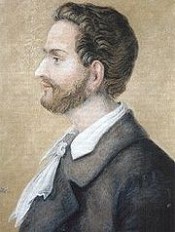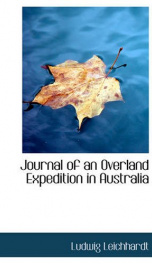Leichhardt Ludwig

Friedrich Wilhelm Ludwig Leichhardt, known as Ludwig Leichhardt, (23 October 1813 - c.1848)[1] was a Prussian explorer and naturalist, most famous his exploration of northern and central Australia. Leichhardt was born in Trebatsch, Prussia, the fourth son and sixth of the eight children of Christian Hieronymus Matthias Leichhardt, farmer and royal inspector of peat, and his wife Charlotte Sophie, née Strählow.[1]. Between 1831 and 1836 Leichhardt studied philosophy, language, and natural sciences at the Universities of Göttingen and Berlin but never received a university degree. He moved to England in 1837 where he continued his study of natural sciences at various places, including the British Museum, London and the Jardin des Plantes, Paris, and undertook field work in several European countries including France, Italy and Switzerland. In 1842 Leichhardt voyaged to Sydney, Australia. He led three major expeditions to explore parts of northern and central Australia. The first, mounted as a private expedition, started on October 1, 1844 from Jimbour on the Darling Downs and ended after a nearly 4800 km overland journey in Port Essington on December 17, 1845. He returned to Sydney by boat to a hero's welcome. The Journal of an Overland Expedition in Australia, from Moreton Bay to Port Essington, a Distance of Upwards of 3000 Miles, During the Years 1844-1845 by Leichhardt describes this expedition. The second expedition, now with the assistance of a Government grant and substantial private subscriptions, starting in December 1846, was supposed to take him from the Darling Downs to the west coast of Australia and ultimately to the Swan River and Perth. After covering only 800 km the expedition team was forced to return in June 1847 due to heavy rain, malarial fever and famine. After recovering, Leichhardt spent 6 weeks in 1847 to examine the course of the Condamine River and the country between the route of another expedition led by Mitchell in 1846 and his own route, covering nearly 1,000 km. In April 1847 Leichhardt shared annual prize of the Paris Geographical Society, for the most important geographic discovery with Rochet d'Héricourt. Soon afterward, on 24 May, the Royal Geographical Society, London, awarded Leichhardt its Patron's Medal as recognition of 'the increased knowledge of the great continent of Australia' gained by his Moreton Bay-Port Essington journey.[1] In March 1848 Leichhardt again set out from the Condamine River to reach the Swan River. He was last seen on April 3 1848 at McPherson's Station, Coogoon on the Darling Downs. His disappearance after moving inland, although investigated by many, remains a mystery. Four years after Leichhardt's disappearance, the Government of New South Wales sent out a search expedition under Hovendon Hely. The expedition found nothing but a single campsite with a tree marked "L" over "XVA". In 1858, another search expedition was sent out, this time under Augustus Gregory. This expedition found only a couple of trees marked "L". In 1865, Duncan McIntyre was shown a tree marked "L" on the Flinders River near the Gulf of Carpentaria. This mark was almost certainly made by William Landsborough; or if it was made by Leichhardt then it would have been during his 1844 journey to Port Essington. However, McIntyre reported to Melbourne that he had found traces of Leichhardt, and was subsequently appointed leader of a search expedition. This expedition was a complete failure, not even reaching the search area. In 1869, the Government of Western Australia heard rumours of a place where the remains of horses and men killed by indigenous Australians could be seen. A search expedition was sent out under John Forrest, but nothing was found, and it was decided that the story might refer to the bones of horses left for dead at Poison Rock during Robert Austin's expedition of 1854. The mystery of Leichhardt's fate remained in the minds of explorers for many years: during David Carnegie's 1896 expedition through the Gibson and Great Sandy Deserts, he encountered some indigenous Australians who had amongst their possessions an iron tent peg, the lid of a tin matchbox, and part of the ironwork of a saddle. Carnegie speculated that these were originally from Leichhardt's expedition. In 2006 Australian historians authenticated a tiny brass plate bearing Leichhardt's name, originally discovered by an Aboriginal stockman near Sturt Creek on the Western Australia—Northern Territory border in about 1900. When found, the plate was attached to a partially burnt shotgun slung in a boab tree which was engraved with the initial "L".[2] The plate is now part of the National Museum of Australia collection. The Inner Western Sydney suburb of Leichhardt and the surrounding Municipality of Leichhardt are named for him, as is the Ipswich suburb of Leichhardt and the Leichhardt Highway in Queensland. Leichhardt's last expedition was the inspiration for the novel Voss by Patrick White.
do you like this author?
What readers are saying
What do you think? Write your own comment on this book!
write a commentWhat readers are saying
What do you think? Write your own comment on this author!
write a commentBook list

Journal of an Overland Expedition in Australia : from Moreton Bay to Port Essington, a distance of upwards of 3000 miles, during the years 1844-1845
Series:
Unknown
Year:
Unknown
Raiting:
3/5
FROM MORETON BAY TO PORT ESSINGTON, A DISTANCE OF UPWARDS OF 3000 MILES, DURING THE YEARS 1844-1845
Show more
add to favoritesadd In favorites
Book list

Journal of an Overland Expedition in Australia : from Moreton Bay to Port Essington, a distance of upwards of 3000 miles, during the years 1844-1845
Series:
Unknown
Year:
Unknown
Raiting:
3/5
FROM MORETON BAY TO PORT ESSINGTON, A DISTANCE OF UPWARDS OF 3000 MILES, DURING THE YEARS 1844-1845
Show more
add to favoritesadd In favorites
What readers are saying
What do you think? Write your own comment on this author!
write a commentGenre
if you like Leichhardt Ludwig try:
readers also enjoyed
What readers are saying
What do you think? Write your own comment on this author!
write a commentGenre
if you like Leichhardt Ludwig try:
readers also enjoyed
Do you want to exchange books? It’s EASY!
Get registered and find other users who want to give their favourite books to good hands!

